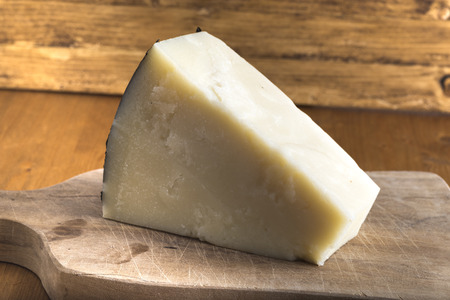Cheese
ricotta cheese

The name ricotta comes from Latin recocta, "cooked twice". It is a milk product. Ricotta is mistakenly referred to as a cheese or soft cheese, but it is not. Ricotta is not made from the cheese substance in milk, casein, but from the waste product whey. It is simply a whey product like the Norwegian brown cheese.
We have different types of ricotta made from different types of milk.
- Ricotta Fresca (fresh ricotta): is a white, soft, unripened cheese. It has a mild, sweet taste as it is made from fresh, sweet whey. Originally, ricotta was made from whey from the production of sheep's cheese. The cheese is used in both sweet desserts (e.g. in Sicilian cannoli) and savory dinner foods (e.g. as a filling for fresh pasta and pie dough).
- Ricotta salata (salted ricotta): salt is added to increase shelf life and to dry out the product. This is made in Sicily, Sardinia, in Calabria, Abruzzo and in Puglia etc. (in all southern regions) This is used grated on pasta instead of parmigiano.
- Ricotta stagionata (aged ricotta): a typical ricotta salata is made in the Valdesi valleys near Turin, where it is called sara's part fen. They use milk from animals that graze at an altitude of over 600 meters above sea level. We eat saras with blueberry jam, elderberries and honey. It is also used as a filling in fresh pasta.
- Ricotta info (oven-baked ricotta): a week after salting, the ricotta is placed in a mold in the oven. Ricotta infornata is a typical product from Sicily. The cheese is used grated on pasta.
Pecorino romano

Pecorino Romano is one of the oldest Italian cheeses. It was "born" for approx. 2000 years ago.
The cheese is made from sheep's milk and is produced in Lazio, Tuscany and Sardinia.
It matures for at least 5 months. The curd is firm and hard, the color is white and the taste is quite salty.
Pecorino romano tastes good grated for pasta and in pieces for salads and as snacks.
Gorgonzola

Gorgonzola is a classic blue cheese made from cow's milk.
It originally comes from a small town called Gorgonzola, which is just outside of Milan. It has been produced there since the 800th century.
Today it is produced in Lombardy and Piemonte.
We have two different types of gorgonzola: gorgonzola dolce and gorgonzola piccante.
Desserts: this cheese has a creamy consistency and a delicate, slightly sweet and mild taste. It matures in 50 days
piccante: this cheese has a crumbly consistency and a strong taste. It matures for at least 80 days.
Mozzarella
If you think mozzarella is boring, it's probably because you haven't tasted real mozzarella.
It tastes simply delicious.
You can recognize a good mozzarella by its elastic consistency, its smooth surface and by its color, which should be white.
Mozzarella is best when it is at room temperature. Cold destroys the good, sweet and fresh taste of milk.
In Italy we make different types of mozzarella.
The most famous types are:
Mozzarella di bufala(buffalo mozzarella): is a mild and fresh cheese with a slightly sour taste. The name says that the mozzarella is made from buffalo milk. The production area is the Campania region.
Mozzarella Fior di latte: is the usual mozzarella that you find at the store. It is made from cow's milk and has a special fiber structure.
Mozzarella mista: it is made from a mixture of cow's milk and buffalo's milk.
Smoked mozzarella: it is made from buffalo milk and is smoked.
Burrata: similar to mozzarella, but has a much softer consistency inside the cheese. The taste is mild and buttery.
The difference between Parmigiano Reggiano and Grana Padano

These cheeses are Italy's most eaten cheeses.
So what is the difference between these two?
In many ways they are similar, such as in shape, dimensions and weight and on some others they are different.
They are produced in different areas of Italy.
Grana Padano comes from 32 districts in 5 regions (counties): Piedmont, Lombardy, Veneto, Emilia Romagna, Trentino Alto Adige.
Parmigiano Reggiano comes “only” from the Emilia Romagna region and from the Mantova district.
Both cheeses are made from reduced-fat cow's milk and milk is used from both morning and evening milking. For Grana Padano the milk is skimmed both morning and evening, for Parmigiano Reggiano only the evening milk is skimmed. Parmigiano Reggiano is therefore fatter than Grana Padano. This is why Grana Padano ripens first. In fact, this cheese is matured after 9 months, while Parmigiano Reggiano must have at least 12 months of maturation.
When it comes to feeding the cows, there are also differences. In the production of Parmigiano Reggiano, the cows must have fodder from the area they graze and within the geographical area, as the DOP rules dictate. While in the production of Grana Padano it is possible to use acidified feed in addition to fresh feed. Because of that, they are supplied with "lysozyme", which is a natural protein extracted from eggs.
The taste of Grana Padano is much milder than Parmigiano Reggiano which, on the other hand, has a nutty taste.
Grana Padano is generally considered lower quality (wrongly, in my opinion) and it is usually cheaper than Parmigiano Reggiano.
Most people think that the two cheeses are grated cheeses, but... have you already tasted a thin slice of Parmigiano Reggiano with a small drop of a good balsamic (of high quality)?. It tastes unashamedly good! You have to try it! It is perfect as finger food.





